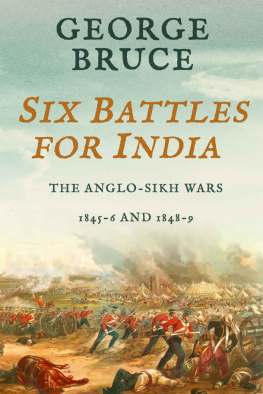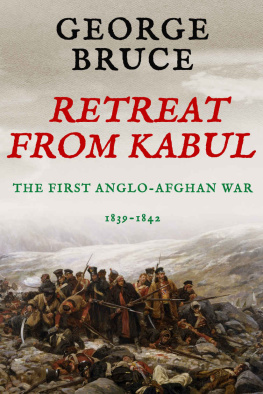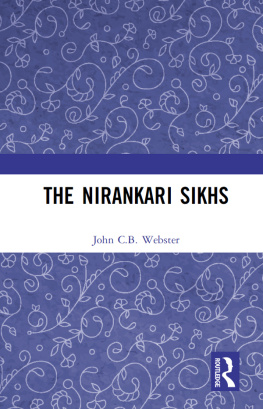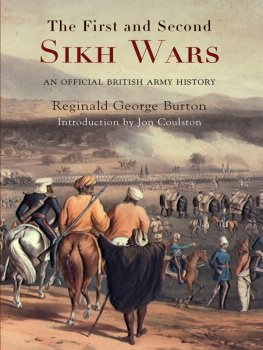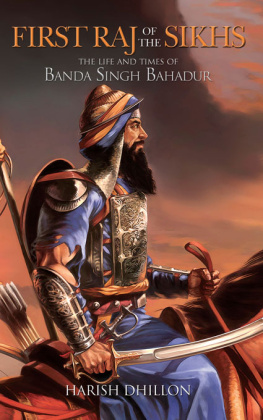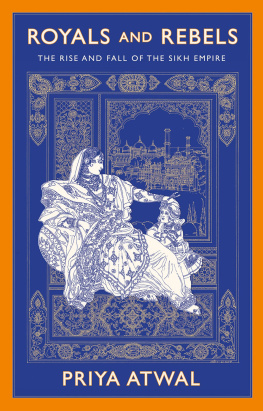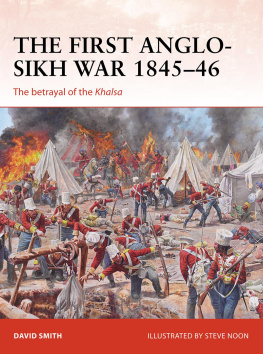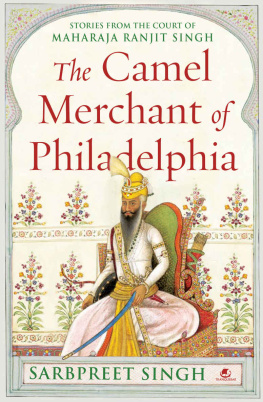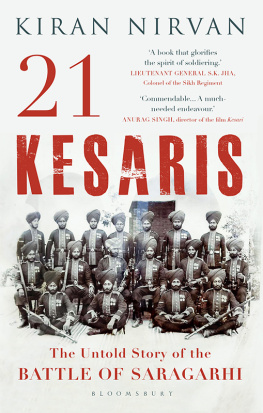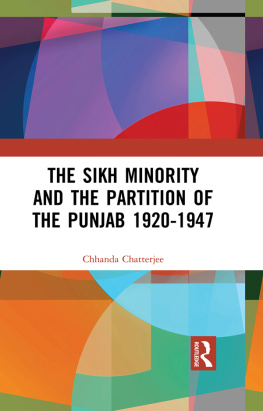SIX BATTLES FOR INDIA
The Anglo-Sikh Wars: 1845-6, 1848-9
GEORGE BRUCE
Table of Contents
Part One: The First Anglo-Sikh War, 1845-6
1: Farewell
General Sir Hugh Gough gave a ball at the military outpost of Ambala, northern India, on the night of the tenth of December, 1845. As usual, the officers scarlet and blue uniforms laced with silver and gold, outshone the ladies sombre crinolines, as they danced to waltzes played with more vigour than melody by the band of the 3rd Light Dragoons. The music, the ritual and the pleasure of such gatherings inevitably awoke memories of England, but perhaps never more poignantly than on this particular night, when tension and excitement among the men, regret and fear among the women, would have been so much felt.
The British Empire was rising, the forward policy ruled again in India after its temporary eclipse, and though nobody, in those days of the stiff upper lip, would have dreamed of saying so, it was a farewell ball. They danced on the brink of war, for the men were to march at dawn and it was an open secret that the move heralded the long-expected clash with the warlike Sikhs. General Gough, the commander-in-chief in India, had been methodically preparing for more than a year.
Experienced, but oft-criticised was Sir Hugh Gough. This warm-hearted, white-haired Irishman aged sixty-six, with the stamina of a cavalry charger, had fought in more battles than any other British officer living, except the Duke of Wellington. And Gough still loved fighting, invariably taking his place in the thick of the battle, conspicuous in his white fighting coat. His detractors said that he was always too eager to get at and destroy the inimy. And that the smell of gunpowder drove him to such a pitch of excitement that all his strategy and tactics were forgotten in the urge for cold steel and the irresistible infantry charge. If it was true, his bold tactics had succeeded in the past at Talavera, where Wellington had promoted him on the field to Lieutenant-Colonel, when he was only twenty-eight; at Barossa, at Nivelle, and, more recently, as commander-in-chief of the expeditionary force in China. So Gough brought an aura of success with him to this war looming with the Sikhs.
Nevertheless, the strength and size of the Sikh forces in relation to his own readiness had for long worried him and for months he had tried to reinforce his forward troops at the outpost of Ferozepore. But Sir Henry Hardinge, the Governor-General of India, unwilling to add to the East India Companys financial troubles, had refused to pass Goughs plans. Ineffectually trying to avoid war, he had stubbornly thwarted him, once countermanding his movement orders that would even the balance with the Sikh forces near the frontier. I have ample to cut the Sikhs in pieces, but they are not in hand, as they should be, Gough confessed in an anxious letter to his son.
Only too well justified were Goughs suspicions of the Sikhs. For unknown to him, this very night, while he and his officers were dancing at Ambala, the Sikh army had burst out of the Punjab and was crossing the river Sutlej to cut off General Sir John Littlers small force at Ferozepore. No doubt, the 3rd Light Dragoons would have sounded more peremptory tunes than waltzes on their trumpets had Gough heard of this invasion while dispensing the hospitality he loved.
War between British and Sikh had threatened once before. It had been averted at the last moment by their former leader, Maharajah Ranjit Singh. This ruler of genius with one dark glittering eye, an insatiable lust for women and a passion for raw spirit laced with meat-juice and opium, had tried in 1809 to push his dominions across the Sutlej as far south as Ambala. The British had moved up an army from Delhi and, under this threat, Ranjit had withdrawn, signing a treaty stipulating that neither power would henceforward move an army across the river. Friendship between the two countries had thereafter held good for thirty-six years, until Ranjit Lion of the Punjab, as both friends and enemies called him died aged fifty-nine.
The smoke from his funeral pyre was the signal for anarchy. During the six years after his death, murder ended the lives of all who sat the throne except the boy maharajah, Prince Duleep Singh. From the boys nymphomaniac mother, the Maharani Jindan, the unruly Sikh army, the Khalsa, then seized power and clamoured for war with the British. The sword was a symbol of the Sikh religion and for years the more far-sighted British had predicted trouble with this nation whose urge to expand was equalled only by their own. And now the moment had come. The Khalsa, the strongest army raised in Asia, had crossed the Sutlej to challenge British rule in India.
So it was that wives and sweethearts in the cold early morning at Ambala said last farewells to menfolk they might never see alive again. With red and white plumes streaming from their tall shakoes, the 3rd Light Dragoons, in dark blue tunics, rode off along the first of the one hundred and forty miles of sandy track that passed for the road to Ferozepore. The advance party of the division that expected to reinforce this outpost already cut off, they were followed by the 4th and 5th regiments of Native Cavalry, a sea of brown faces, brilliant turbans and heavy black moustaches.
General Gough was still unaware that the Sikhs had embarked on war. Not until next day did he set off with the rest of the divisions three British and five Indian infantry regiments, with three troops of Horse Artillery, the troopers great brass helmets gleaming in the sun, their gun carriages rattling.
Thus the British went to war, five thousand miles from their homeland. Many of them would never see its green fields again, but they went with an extraordinary light-heartedness. At daybreak reveille sounded, and we all formed up in front of the barracks, gave three cheers and then set out on our march, the band playing of course, The Girls We Left Behind Us, wrote Lieutenant Sandford to his sisters in England.
Their light-heartedness stemmed from faith in themselves, in their army and in their Almighty God. God was on the side of Right, and that meant England. The Sikhs were strong, but the Redcoats believed themselves invincible, when led by good officers. Colours flying, drums beating, the invincible army marched westwards over the sandy plains. They knew that ex-officers of Napoleons Grand Army and a remarkable American soldier of fortune, Colonel Alexander Gardner, had drilled and trained the Sikh army to make it a match for the British or any other. But probably no one, from Gough to the humblest foot soldier doubted that they would crush those Sikh rascals or them Saikhs, as officers and men each liked to call them.
2: Sikhism
The Punjab, called Land of the Five Rivers, is a geographical entity often described as shaped like a triangle formed by the Indus flowing first from south-east to north-west and then, changing course suddenly, from north-east to south-west to form two sides. The Sutlej, flowing almost from east to west forms the base. In the north-east the Punjab contains Kashmir and is separated from Tibet by the Himalayas. Beyond the Indus to the north-west it is bounded by the rugged Sulaiman and Hindu Kush mountain ranges, cleft by the Kyber, Bolan and Gomal passes through which from time to time during the centuries have poured the invaders from Persia and Afghanistan.
Five great rivers the Jhelum, Chenab, Ravi, Beas and Sutlej rise in the Himalayas and flow in a south-westerly direction nine hundred miles across a great flat plain, until finally, one by one all unite with the Indus. The stretches of land between these rivers are called doabs beggars mantles fringed with gold. Modern irrigation has since changed the lands character, but in 1845, where the precious water lapped the rich alluvial soil, the peasant harvested sugar, maize and cotton, yet beyond, the sparse soil nourished only thornbush and tamarisk, from which the goat and the camel eked a little nourishment.
Next page
